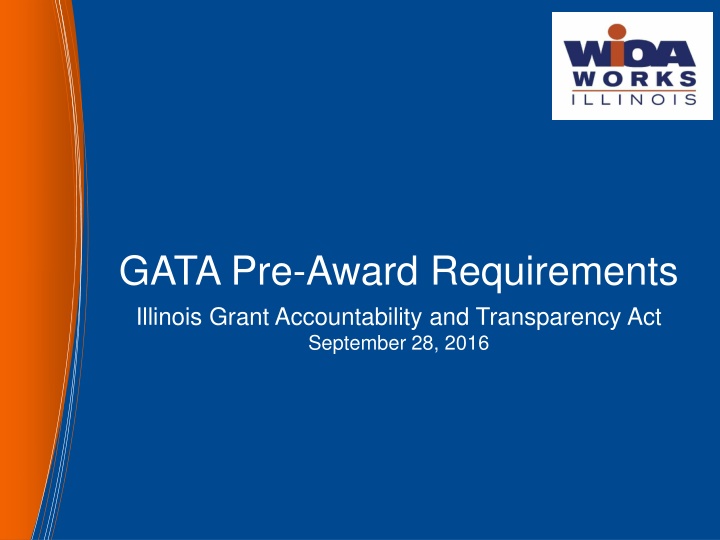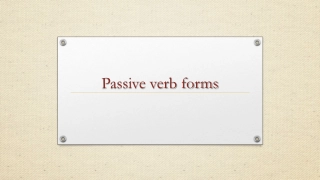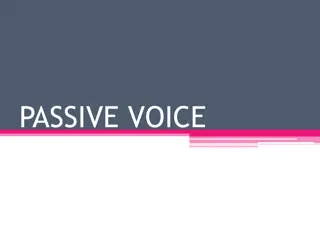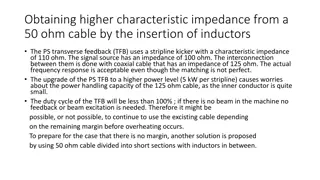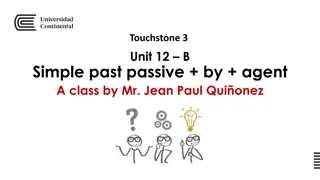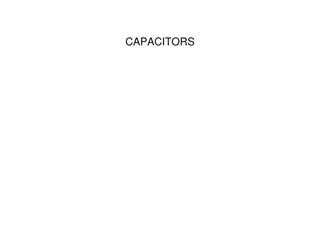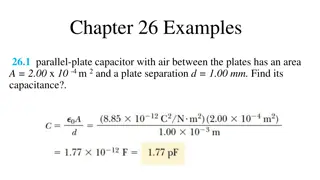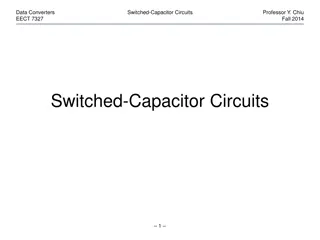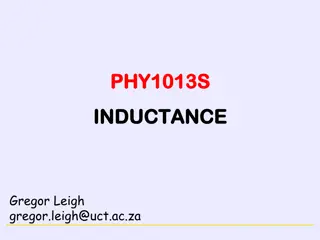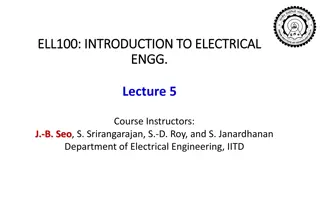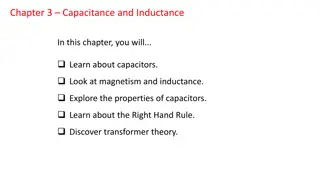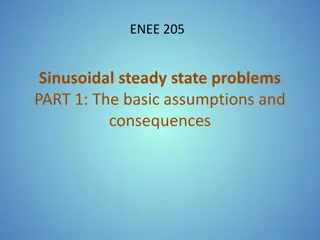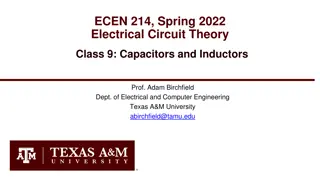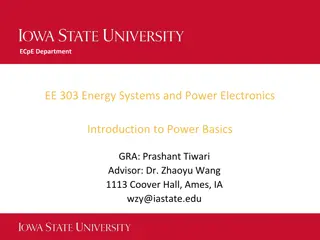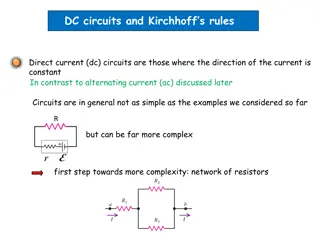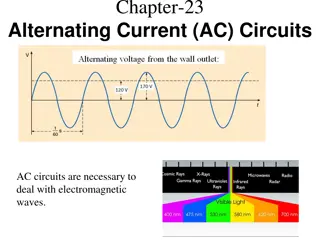Passive Components in Integrated Circuits: Resistors, Capacitors, Inductors
Passive components play a crucial role in integrated circuits, including resistors for DAC, amplifiers, and voltage references, capacitors for analog filters and ADCs, and inductors for RF circuits. Precise resistors and capacitors are essential for high accuracy in analog applications. Integrated resistors have specific layout requirements, including considerations for width and parasitic components. Polysilicon resistors exhibit unique characteristics such as sheet resistance, TCR, and linearity, making them suitable for various applications in microelectronic system design.
Download Presentation

Please find below an Image/Link to download the presentation.
The content on the website is provided AS IS for your information and personal use only. It may not be sold, licensed, or shared on other websites without obtaining consent from the author.If you encounter any issues during the download, it is possible that the publisher has removed the file from their server.
You are allowed to download the files provided on this website for personal or commercial use, subject to the condition that they are used lawfully. All files are the property of their respective owners.
The content on the website is provided AS IS for your information and personal use only. It may not be sold, licensed, or shared on other websites without obtaining consent from the author.
E N D
Presentation Transcript
GATA Pre-Award Requirements Illinois Grant Accountability and Transparency Act September 28, 2016
Grantee Pre-Award Requirements that must be Completed Prior to Grant Award Execution Grantee Registration Grantee Pre-Qualification Financial and Administrative Risk Assessment (ICQ Internal Control Questionnaire) Programmatic Risk Assessment Effective FY17 for most grantees. Exemption for LWIAs for PY2016 for WIOA and Trade grants. LWIAs can start process now.
GATA Website http://grants.illinois.gov Grantee Links Tab is the entry point for the grantee pre- award process (registration, pre-qualification, risk assessments) Centralized Indirect Cost System can be accessed from the dropdown menu in the Grantee Links Tab FAQs Training Modules Forms and Indirect Cost Rate Templates Department of Labor Indirect Cost Rate Guide
Grantee Registration All grantees must be registered with the State of Illinois Done by completing and submitting a Grantee Registration form A link to the form is provided from Grantee Links Tab State receipt of the form triggers grantee pre- qualification verifications
Grantee Pre-Qualification FY-17 Pre-Qualification includes verification of: Current DUNS number Current SAM CAGE Code Good Standing with Secretary of State Not on Federal Excluded Parties List
Pre-Qualification Notification If there are no issues, State sends email to communicate Qualified status. If there are issues, State emails qualification issue(s) and asks entity to notify State when remediation completed DUNS number is not current SAM CAGE Code is not current Not in Good Standing with Secretary of State On the Federal Excluded Parties List (cannot be remediated)
GATA Framework for Risk Assessment Fiscal Risk Assessment (ICQ) is automated Grantee receives automated email with ICQ URL link (Triggered by Grantee Registration) Grantee completes and submits automated ICQ Programmatic Risk Assessment will be conducted by the awarding agency in the application process. It is unique to the award. Risk profiles will be determined based on the two risk assessments. Risk profile will determine grant specific conditions and monitoring.
Indirect Cost Rate An indirect cost rate is simply a device used for determining the appropriate amount of indirect costs each program should bear. An indirect cost rate is the ratio between the total indirect expenses and some direct cost base. Options available for a Grantee to receive an Indirect cost rate: Current Federally Approved Indirect Cost Rate as a result of being a direct recipient from a Federal awarding agency Negotiate a rate with the State of Illinois by first submitting an Indirect Cost Rate Proposal (ICRP) to the State of Illinois Centralized Indirect Cost Unit Elect to use the Federal 10% de minimis rate of Modified Total Direct Cost (MTDC) Use a restricted or special rate that is statutorily required within program rules.
Centralized Indirect Cost Rate System Grantees will not be invited to the Centralized Indirect Cost Rate System until the ICQ (Internal Controls Questionnaire) is approved. Indirect cost rate proposals or elections of other rate options must be received within 90 days from the date of the award. There is an exemption for LWIAs for WIOA and Trade grants for PY-16. However, LWIAs should start the process prior to 3/31/17.
Who is required to use the Crowe Horwath CARS system for indirect cost rates? Any organization that receives a grant from a state of Illinois grant making agency. If a grantee organization has a federally negotiated rate, they are required to provide information through the indirect cost rate system. The system will provide instructions to complete this process. If a grantee organization chooses to elect the 10% de minimis rate, they are required to make this election in the indirect cost rate system. The system will provide instructions to complete this process.
Who is required to use the Crowe Horwath CARS system for indirect cost rates? - Continued If a grantee organization elects to negotiate an indirect cost rate, they are required to submit an indirect cost rate proposal. Templates, examples and training are available on the GATA website Grantee Links tab. The system will provide instructions to complete this process. If a grantee organization elects not to charge a rate, they are required to formally make this election through the centralized indirect cost rate system. The system will provide instructions to complete this process. Local Education Agencies (LEA) will be allowed to use their rates negotiated with the Illinois State Board of Education and will also be accepted by state grant making agencies. LEAs will not be required to negotiate a rate with the State of Illinois centralized indirect cost rate contractor and state grant making agencies will accept the rate.
Centralized Indirect Cost Rate System Guidelines Illinois received permission from the Federal Government to centralize the negotiation of indirect cost rates. This allows grantees to negotiate one rate if they receive grants from multiple State of Illinois agencies All State of Illinois agencies must accept the centralized negotiated rate unless there are federal program limitations, cap requirements or supplanting issues.
Centralized Indirect Cost Rate System Guidelines - Continued A grantee may volunteer to accept a lower indirect cost rate, but state agencies are not allowed to force or coerce a grantee to take a lower rate All grantees are required to make the indirect cost rate elections in the centralized system The organization has 90 days from the issuance of their first award to elect an option in the Centralized Indirect Cost Rate System.
GATA Website Centralized Indirect Cost Rate System From the dropdown menu on the Grantee Links Tab, select Centralized Indirect Cost System FAQs, Training Modules, Forms, and Templates are available on the website. There is a training module on Indirect Cost Rate Proposals.
Resources https://www.grants.Illinois.gov http://www.illinoisworknet.com/GATA https://www.doleta.gov/grants/UniformGuidance.cfm http://etasmarttraining.com/pdf/Single_Track_Region1.pdf
NEXT STEPS Complete the GATA Grantee Registration and Pre- Qualification by October 17, 2016 Grantee Registration Grantee Pre-Qualification Financial and Administrative Risk Assessment Review Indirect Cost Rate Options Complete the information requested by the Centralized Indirect Cost Rate System by March 31, 2017 Complete WIOA Program Year 2017 formula grant application using the revised indirect cost information (as applicable).
